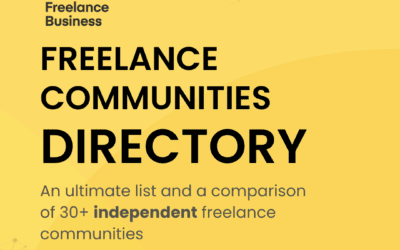Kamila Zahradnickova is a behavioural designer, applying behaviour science to marketing and business. She solves customer-related questions by leveraging research on perception, motivation, and decision-making. Favourite tools? Gamification, nudge, and identity framework. Kamila thrives in a fast-paced environment and is fond of social impact projects. These days, she is busy developing her new startup Lakmoos which uses AI to screen the potential of your business ideas.
Kamila, tell us how it has been the last 2-3 years?
Turbulent! But also incredibly rewarding. I always suspected I could enjoy business, but I never really knew what it entails. So when I started freelancing, I took it as an experiment. Freelancing is such a low barrier to starting business: minimum administrative, all the freedom. I thought that if I don’t like it, I can decide overnight to just stop and go get employed. But I’m glad I discovered that business could be quite suitable for my skills and mindset, and I felt ready to take on more responsibilities.
I started as a graphic designer and I infused my design with what I knew from behavioural science, which is my academic background. I worked a lot with perception, attention, and all that. But then I discovered I bring most value on the strategic level. I pivoted a few times, and now I’m mainly focused on projects that apply behavioural science and on corporate research.
What was the most difficult part of starting your freelance career?
Now knowing anything! I didn’t know how an invoice should look like or when exactly I was supposed to send it. I had no idea where to get clients. Luckily, I reached out to other seasoned freelancers, and they were extremely patient with me asking basic questions. That helped me a lot.
I also undervalued my work a lot. I wanted to make up for the fact I didn’t have much experience, so I set my prices ridiculously low. I hoped to filter friendly clients who are willing to give me a shot and pay less for their bold move. But I didn’t filter out people who would forgive me sending an invoice late, instead, I attracted people who didn’t value my work. Those had also the highest expectations. I remember my second client was a restaurant wanting to redesign their menu. I gave them a quote of like 100 euros. Furthermore, I ended up spending more than 50 hours on them, and it was not pleasant either. The client yelled at me on the phone, and always wanted to meet in person. Those were COVID times, I remind you. But you know what’s the best part? They never paid me. They took the 24th version, printed it, and refused to pay me. That was really discouraging, but again, my mentors helped me move forward.
See Kamila’s takeaways from the first Freelance Business Month 2020.
What do you love about freelancing?
I am crafting a job for myself, based on my skills, approach and mindset. I have the space to find that perfect gap on the market where I bring most value. That is precious!
And I absolutely adore the variety of my clients and their fields. I did projects for Nestlé, but also The Nature Conservancy, fintech startups, designer studios, and I always accidentally learned something new about their field.
Freelancing also helped me to grow. I don’t think I would have got as much experience if I was employed, even if I was working on the same projects. It would have been more comfortable, surely, but freelancing helps me grow. I need to know the basics of pricing, negotiation, market research, and I need to know how to form good relationships with clients and other freelancers.
You are now a business owner and a founder of a startup Lakmoos. How did that happen?
That’s such a cute story. I did a freelancing project for VC fund. One of their startups wanted to pivot but was not sure, and we were looking for ways to prototype it before recoding the whole app, that would take months and sounded too risky. So we build a mock survey testing customer’s feedback. When you’re trying to find out the optimum price for your service or product, for example, you can never, I repeat – never, ask “How much would you pay for X?” People will give you a number that’s completely unfounded and ends up misleading you. Luckily, there’s plenty of research on “willingness to pay” pointing to the right ways to get feedback on pricing. We added custom blocks that were supposed to reduce bias in these answers.
That was when I first notice the problem: How do you tell which ideas are worth pursuing? Before you invest time and money into prototyping? Or research?
I started looking more into the art of choosing good ideas, and a few months later, I reunited with Jan and Roman, my technical co-founders. Jan and I used to go to scout summer camps together and haven’t seen each other for almost 10 years. We were intrigued by our fields, machine learning and behavioural science, and thought we could try to face the challenge of picking good ideas. I wish we had something like Lakmoos to help us decide if our idea was good enough, but all we could do was to start prototyping.
How exactly Lakmoos works? And why is it important?
Lakmoos automates innovation. We screen pre-prototype ideas, benchmark them, and deliver data that help innovators decide if their ideas are worth pursuing. We forecast success of innovation.
This is a game changer for companies. Research shows us that employees are just as innovative as entrepreneurs (and freelancers!). The difference is that entrepreneurs stop dreaming and start doing. Companies are full of hidden, dormant innovation, they just do not know how to access it. Companies bring so many barriers to their innovators: suggestion boxes, long waiting time, unreasonable expectations for pitches. I don’t blame employees who keep their brilliant idea for themselves, it is not worth sharing in a lot of cases.
Our goal at Lakmoos is to set the bar for innovation as low as possible. Any employee can find five minutes to describe an idea, and we fetch all the data their supervisor needs to give them a green light. We break the vicious circle of meetings and pitching and approving. It’s never been easier and cheaper to explore hundreds of ideas a day.
Our goal is also to kill bad ideas fast. You don’t want to spend a month on an idea that’s never going to happen. You don’t want to hear your idea sucks after missing the third party because you were assembling your business plan. Lakmoos is the first indicator that innovators can use the same day the idea crosses their mind.
What helped you to take off Lakmoos?
Strong will! We’re still at the beginning. The startup ecosystem is incredibly supportive, and we found so many people willing to give us advice, share feedback or make introductions.
What would you recommend to anyone who is starting developing an idea?
Use Lakmoos to check if it’s worth your energy! Seriously. Always find ways to prototype your idea in stages. I know it’s tempting to dive into the hard work right away, but it’s smarter to test in iterations. Write your assumptions, and find ways to test them. Build a low-fidelity prototype and get feedback from potential clients. If you want to build an app for public transport, for example, take pen and paper, sketch the screens and go ask people at the bus stop.
Your goals for the next 2-3 years.
In the next months I am set to
- Finish building prototype of Lakmoos Testing Centre
- Publish three research articles
- Successfully pilot five corporate partnerships
But what I’m really hoping for is to start cloning people and build an empire. We’ll see how our Seed round goes.




